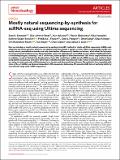| dc.contributor.author | Simmons, Sean K | |
| dc.contributor.author | Lithwick-Yanai, Gila | |
| dc.contributor.author | Adiconis, Xian | |
| dc.contributor.author | Oberstrass, Florian | |
| dc.contributor.author | Iremadze, Nika | |
| dc.contributor.author | Geiger-Schuller, Kathryn | |
| dc.contributor.author | Thakore, Pratiksha I | |
| dc.contributor.author | Frangieh, Chris J | |
| dc.contributor.author | Barad, Omer | |
| dc.contributor.author | Almogy, Gilad | |
| dc.contributor.author | Rozenblatt-Rosen, Orit | |
| dc.contributor.author | Regev, Aviv | |
| dc.contributor.author | Lipson, Doron | |
| dc.contributor.author | Levin, Joshua Z | |
| dc.date.accessioned | 2023-01-13T15:16:35Z | |
| dc.date.available | 2023-01-13T15:16:35Z | |
| dc.date.issued | 2022 | |
| dc.identifier.uri | https://hdl.handle.net/1721.1/147097 | |
| dc.description.abstract | <jats:title>Abstract</jats:title><jats:p>Here we introduce a mostly natural sequencing-by-synthesis (mnSBS) method for single-cell RNA sequencing (scRNA-seq), adapted to the Ultima genomics platform, and systematically benchmark it against current scRNA-seq technology. mnSBS uses mostly natural, unmodified nucleotides and only a low fraction of fluorescently labeled nucleotides, which allows for high polymerase processivity and lower costs. We demonstrate successful application in four scRNA-seq case studies of different technical and biological types, including 5′ and 3′ scRNA-seq, human peripheral blood mononuclear cells from a single individual and in multiplex, as well as Perturb-Seq. Benchmarking shows that results from mnSBS-based scRNA-seq are very similar to those using Illumina sequencing, with minor differences in results related to the position of reads relative to annotated gene boundaries, owing to single-end reads of Ultima being closer to gene ends than reads from Illumina. The method is thus compatible with state-of-the-art scRNA-seq libraries independent of the sequencing technology. We expect mnSBS to be of particular utility for cost-effective large-scale scRNA-seq projects.</jats:p> | en_US |
| dc.language.iso | en | |
| dc.publisher | Springer Science and Business Media LLC | en_US |
| dc.relation.isversionof | 10.1038/S41587-022-01452-6 | en_US |
| dc.rights | Creative Commons Attribution 4.0 International license | en_US |
| dc.rights.uri | https://creativecommons.org/licenses/by/4.0/ | en_US |
| dc.source | Nature | en_US |
| dc.title | Mostly natural sequencing-by-synthesis for scRNA-seq using Ultima sequencing | en_US |
| dc.type | Article | en_US |
| dc.identifier.citation | Simmons, Sean K, Lithwick-Yanai, Gila, Adiconis, Xian, Oberstrass, Florian, Iremadze, Nika et al. 2022. "Mostly natural sequencing-by-synthesis for scRNA-seq using Ultima sequencing." Nature Biotechnology. | |
| dc.contributor.department | Massachusetts Institute of Technology. Department of Biology | en_US |
| dc.relation.journal | Nature Biotechnology | en_US |
| dc.eprint.version | Final published version | en_US |
| dc.type.uri | http://purl.org/eprint/type/JournalArticle | en_US |
| eprint.status | http://purl.org/eprint/status/PeerReviewed | en_US |
| dc.date.updated | 2023-01-13T14:59:32Z | |
| dspace.orderedauthors | Simmons, SK; Lithwick-Yanai, G; Adiconis, X; Oberstrass, F; Iremadze, N; Geiger-Schuller, K; Thakore, PI; Frangieh, CJ; Barad, O; Almogy, G; Rozenblatt-Rosen, O; Regev, A; Lipson, D; Levin, JZ | en_US |
| dspace.date.submission | 2023-01-13T14:59:44Z | |
| mit.license | PUBLISHER_CC | |
| mit.metadata.status | Authority Work and Publication Information Needed | en_US |
